#integrated flux nebula
Photo
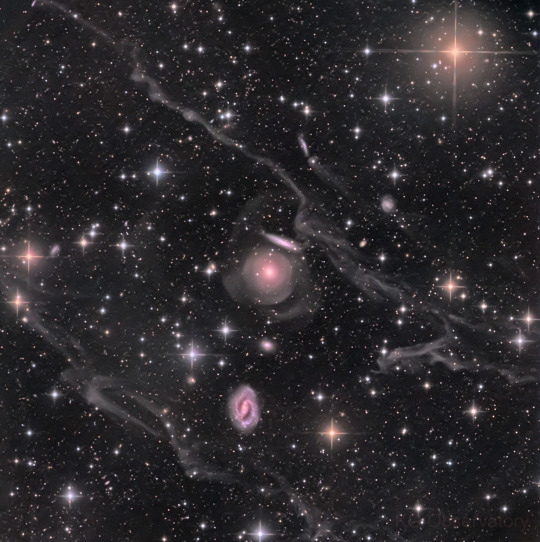
NGC 2634 (center) and NGC 2633 (bottom) // KuriousGeorge
#astronomy#astrophotography#galaxy#spiral galaxy#elliptical galaxy#star-forming galaxy#NGC 2634#NGC 2633#nebula#integrated flux nebula#interstellar dust#dust#camelopardalis
430 notes
·
View notes
Text
The North Star surrounded by Integrated Flux Nebula (IFN)

#astronomy#astronomers#nasa#universe#astrophotography#nasa photos#astrophysics#outer space#nasawebb#hubble space telescope#flux#nebula and quasar#planetary nebula#nebula#i love astronomy#astronomy facts#astrography#astro notes#astronauts#astro observations#astroblr#astro community#astrology observations#space science#space exploration#space#space photography#science#planetary science#galaxies
34 notes
·
View notes
Photo

2023 July 21
Galactic Cirrus: Mandel Wilson 9
Image Credit & Copyright: Gabriel Rodrigues Santos
Explanation: The combined light of stars along the Milky Way are reflected by these cosmic dust clouds that soar 300 light-years or so above the plane of our galaxy. Known to some as integrated flux nebulae and commonly found at high galactic latitudes, the dusty galactic cirrus clouds are faint. But they can be traced over large regions of the sky toward the North and South Galactic poles. Along with the reflection of starlight, studies indicate the dust clouds produce a faint reddish luminescence as interstellar dust grains convert invisible ultraviolet radiation to visible red light. Also capturing nearby Milky Way stars and distant background galaxies, this remarkably deep, wide-field image explores a complex of faint galactic cirrus known as Mandel Wilson 9. It spans over three degrees across planet Earth's skies toward the far southern constellation Apus.
∞ Source: apod.nasa.gov/apod/ap230721.html
61 notes
·
View notes
Text
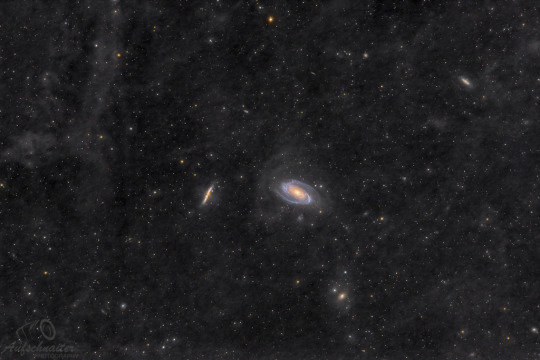
The two dominant galaxies near center are far far away, 12 million light-years distant toward the northern constellation of the Great Bear. On the right, with grand spiral arms and bright yellow core is spiral galaxy M81. Also known as Bode's galaxy, M81 spans some 100,000 light-years. On the left is cigar-shaped irregular galaxy M82. The pair have been locked in gravitational combat for a billion years. Gravity from each galaxy has profoundly affected the other during a series of cosmic close encounters. Their last go-round lasted about 100 million years and likely raised density waves rippling around M81, resulting in the richness of M81's spiral arms. M82 was left with violent star forming regions and colliding gas clouds so energetic that the galaxy glows in X-rays. In the next few billion years, their continuing gravitational encounters will result in a merger, and a single galaxy will remain. This extragalactic scenario also includes other members of the interacting M81 galaxy group with NGC 3077 below and right of the large spiral, and NGC 2976 at upper right in the frame. Captured under dark night skies in the Austrian Alps, the foreground of the wide-field image is filled with integrated flux nebulae. Those faint, dusty interstellar clouds reflect starlight above the plane of our own Milky Way galaxy.
26 notes
·
View notes
Photo

via NASA https://ift.tt/bJKlSBg
Why is Polaris called the North Star? First, Polaris is the nearest bright star toward the north spin axis of the Earth. Therefore, as the Earth turns, stars appear to revolve around Polaris, but Polaris itself always stays in the same northerly direction -- making it the North Star. Since no bright star is near the south spin axis of the Earth, there is currently no bright South Star. Thousands of years ago, Earth's spin axis pointed in a slightly different direction so that Vega was the North Star. Although Polaris is not the brightest star on the sky, it is easily located because it is nearly aligned with two stars in the cup of the Big Dipper. Polaris is near the center of the eight-degree wide featured image, a digital composite of hundreds of exposures that brings out faint gas and dust of the Integrated Flux Nebula (IFN) all over the frame as well as the globular star cluster NGC 188 on the far left. The surface of Cepheid Polaris slowly pulsates, causing the famous star to change its brightness by a few percent over the course of a few days.
5 notes
·
View notes
Text
Galaxy Wars: M81 and M82

The two dominant galaxies near center are far far away, 12 million light-years distant toward the northern constellation of the Great Bear. On the right, with grand spiral arms and bright yellow core is spiral galaxy M81. Also known as Bode's galaxy, M81 spans some 100,000 light-years. On the left is cigar-shaped irregular galaxy M82. The pair have been locked in gravitational combat for a billion years. Gravity from each galaxy has profoundly affected the other during a series of cosmic close encounters. Their last go-round lasted about 100 million years and likely raised density waves rippling around M81, resulting in the richness of M81's spiral arms. M82 was left with violent star forming regions and colliding gas clouds so energetic that the galaxy glows in X-rays. In the next few billion years, their continuing gravitational encounters will result in a merger, and a single galaxy will remain. This extragalactic scenario also includes other members of the interacting M81 galaxy group with NGC 3077 below and right of the large spiral, and NGC 2976 at upper right in the frame. Captured under dark night skies in the Austrian Alps, the foreground of the wide-field image is filled with integrated flux nebulae. Those faint, dusty interstellar clouds reflect starlight above the plane of our own Milky Way galaxy.
Image Credit & Copyright: Andreas Aufschnaiter
2 notes
·
View notes
Text
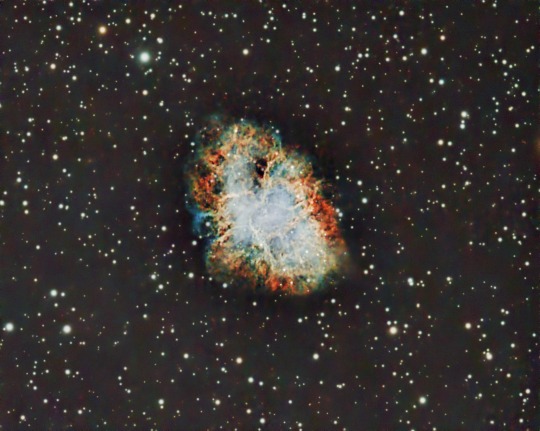
M1 - Crab Nebula
See full resolution image at: https://www.astrobin.com/rejqjs/
The Crab Nebula (catalogue designations M1, NGC 1952, Taurus A) is a supernova remnant and pulsar wind nebula in the constellation of Taurus. The common name comes from a drawing that somewhat resembled a crab with arms produced by William Parsons, 3rd Earl of Rosse, in 1842 or 1843 using a 36-inch (91 cm) telescope. The nebula was discovered by English astronomer John Bevis in 1731. It corresponds with a bright supernova recorded by Chinese astronomers in 1054 as a guest star. The nebula was the first astronomical object identified that corresponds with a historically-observed supernova explosion.
The nebula was independently rediscovered in 1758 by Charles Messier as he was observing a bright comet. Messier catalogued it as the first entry in his catalogue of comet-like objects; in 1757, Alexis Clairaut reexamined the calculations of Edmund Halley and predicted the return of Halley's Comet in late 1758. The exact time of the comet's return required the consideration of perturbations to its orbit caused by planets in the Solar System such as Jupiter, which Clairaut and his two colleagues Jérôme Lalande and Nicole-Reine Lepaute carried out more precisely than Halley, finding that the comet should appear in the constellation of Taurus. It was in searching in vain for the comet that Charles Messier found the Crab Nebula, which he at first thought to be Halley's comet. After some observation, noticing that the object that he was observing was not moving across the sky, Messier concluded that the object was not a comet. Messier then realized the usefulness of compiling a catalogue of celestial objects of a cloudy nature, but fixed in the sky, to avoid incorrectly cataloguing them as comets. This realization led him to compile the "Messier catalogue"
At an apparent magnitude of 8.4, comparable to that of Saturn's moon Titan, it is not visible to the naked eye but can be made out using binoculars under favorable conditions. The nebula lies in the Perseus Arm of the Milky Way galaxy, at a distance of about 2.0 kiloparsecs (6,500 ly) from Earth. It has a diameter of 3.4 parsecs (11 ly), corresponding to an apparent diameter of some 7 arcminutes, and is expanding at a rate of about 1,500 kilometres per second (930 mi/s), or 0.5% of the speed of light.
At the center of the nebula lies the Crab Pulsar, a neutron star 28–30 kilometres (17–19 mi) across with a spin rate of 30.2 times per second, which emits pulses of radiation from gamma rays to radio waves. At X-ray and gamma ray energies above 30 keV, the Crab Nebula is generally the brightest persistent gamma-ray source in the sky, with measured flux extending to above 10 TeV. The nebula's radiation allows detailed study of celestial bodies that occult it. In the 1950s and 1960s, the Sun's corona was mapped from observations of the Crab Nebula's radio waves passing through it, and in 2003, the thickness of the atmosphere of Saturn's moon Titan was measured as it blocked out X-rays from the nebula.
This RGB image is a total of a little under 6 hours of integration over 2 nights (2/18/24 and 2/25/24) consisting of:
- 190 x 60s light frames
- 61 x 120s light frames
- 10 x 180s light frames
Processed in PixInsight using the new GradientCorrection tool (which really helped with the moon-induced gradients on the data taken 2/18).
Celestron C9.25 Edge at F/10
ZWO ASI2600MC Pro Camera
Optolong L-Pro filter
ZWO AM5 mount
Astromania 50mm f/4 Guide Scope
ZWO ASI120MM Mini Guide Camera
ZWO ASIAIR plus controller
0 notes
Text
Flux Nebula Review
Become A Success Forex Trader and Boost Your Income

If you're looking for a comprehensive review of the Flux Nebula trading system, then look no further! This system can help you become a successful Forex trader and boost your income. With step-by-step guidance and proven strategies, Flux Nebula is perfect for traders of all levels. Say goodbye to inconsistent profits and hello to financial success with Flux Nebula!
Introduction: The Genesis of Flux Nebula™
At the core of Flux Nebula™ lies a revolutionary AI algorithm meticulously crafted by Farhad Campbell, a visionary in the field of trading technology. Campbell's deep understanding of market dynamics and his relentless pursuit of excellence culminated in the creation of Flux Nebula™, a tool that promises to decipher complex market signals and provide traders with actionable insights derived from advanced data analysis.
Overview
Product : Flux Nebula™ Trading System
Creator : Marketro LLC
Check it out : Click Here
Discount Price : $186.96
Recommendation : Highly Recommend!
Refund: 30 Days Money-Back Guarantee
Features for the Flux Nebula™ Trading System Review:
AI-Powered Analysis:
Harnessing advanced artificial intelligence algorithms, Flux Nebula™ conducts in-depth analysis of market trends and price movements to generate accurate trading signals.
Comprehensive Asset Coverage:
Flux Nebula™ supports a wide range of trading assets including stocks, Forex pairs, cryptocurrencies, commodities, and indices, allowing traders to diversify their portfolios.
Real-Time Alerts:
Traders receive real-time alerts directly on their preferred devices, including mobile phones and desktops, ensuring they never miss out on potential trading opportunities.
Intuitive Dashboard:
Flux Nebula™ features an intuitive dashboard interface that provides traders with clear insights into market trends, signal strengths, and recommended actions, simplifying the decision-making process.
Customizable Settings:
Traders have the flexibility to customize settings according to their trading preferences and risk tolerance levels, allowing for a personalized trading experience.
Compatibility with Leading Platforms:
Flux Nebula™ seamlessly integrates with popular trading platforms such as Metatrader 4, Metatrader 5, TradingView, and NinjaTrader, providing traders with flexibility and convenience.
No-Repaint Signals:
Flux Nebula™ signals are reliable and non-repainting, ensuring traders can trust the signals they receive for making informed trading decisions.
Multiple Trading Styles Supported: Whether traders prefer scalping, day trading, swing trading, or long-term investing, Flux Nebula™ accommodates various trading styles, catering to diverse trading preferences.
Educational Resources:
Flux Nebula™ provides educational resources and tutorials to help traders understand how to effectively use the system and improve their trading skills.
More Info: Click Here
#Flux Nebula Review#FluxNebula#forex#forextrading#tradingsystems#make money online#make money tips#make money fast
0 notes
Text

APOD: Galactic Cirrus: Mandel Wilson 9 (7/21/23)
The combined light of stars along the Milky Way are reflected by these cosmic dust clouds that soar 300 light-years or so above the plane of our galaxy. Known to some as integrated flux nebulae and commonly found at high galactic latitudes, the dusty galactic cirrus clouds are faint. But they can be traced over large regions of the sky toward the North and South Galactic poles. Along with the reflection of starlight, studies indicate the dust clouds produce a faint reddish luminescence as interstellar dust grains convert invisible ultraviolet radiation to visible red light. Also capturing nearby Milky Way stars and distant background galaxies, this remarkably deep, wide-field image explores a complex of faint galactic cirrus known as Mandel Wilson 9. It spans over three degrees across planet Earth's skies toward the far southern constellation Apus.
© Gabriel Rodrigues Santos
0 notes
Text
Polaris is the nearest bright star toward the north spin axis of the Earth. Therefore, as the Earth turns, stars appear to revolve around Polaris, but Polaris itself always stays in the same northerly direction -- making it the North Star. Since no bright star is near the south spin axis of the Earth, there is currently no bright South Star. Thousands of years ago, Earth's spin axis pointed in a slightly different direction so that Vega was the North Star. Although Polaris is not the brightest star on the sky, it is easily located because it is nearly aligned with two stars in the cup of the Big Dipper. Polaris is near the center of the eight-degree wide featured image, a digital composite of hundreds of exposures that brings out faint gas and dust of the Integrated Flux Nebula (IFN) all over the frame as well as the globular star cluster NGC 188 on the far left. The surface of Cepheid Polaris slowly pulsates, causing the famous star to change its brightness by a few percent over the course of a few days.
📷: Javier Zayaz
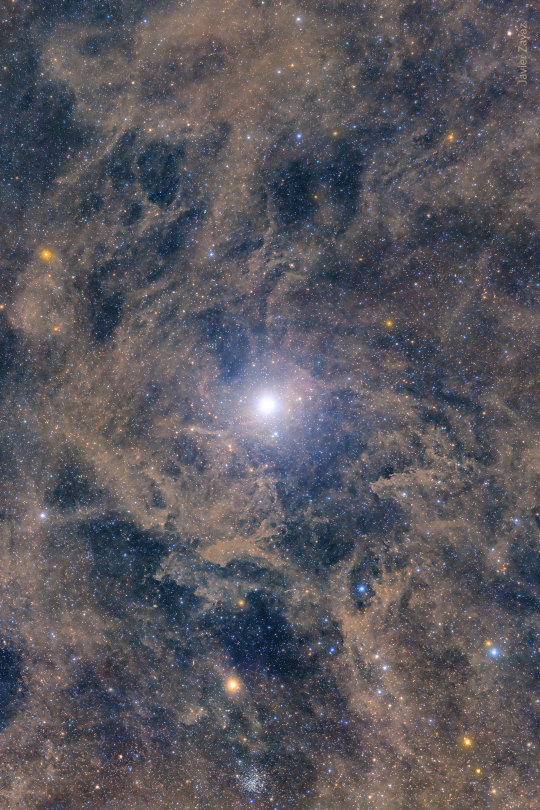
1 note
·
View note
Text
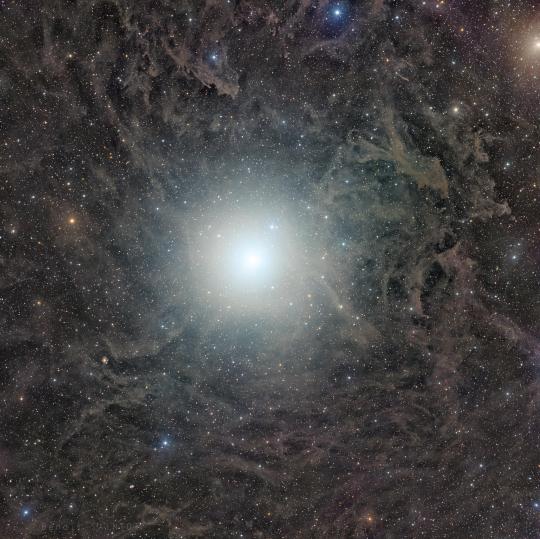
The star Polaris (α Ursae Minoris) and some surrounding dust // AstroBen60
Polaris' name comes from the Neo-Latin stella polaris, meaning "pole star." This name was only coined in the Renaissance when the star had actually become close to the celestial north pole.
#astronomy#astrophotography#star#triple star system#yellow supergiant#supergiant star#polaris#alpha ursae minoris#integrated flux nebula#dust#interstellar dust#ursa minor#etymology
77 notes
·
View notes
Photo

2023 April 11
North Star: Polaris and Surrounding Dust
Image Credit & Copyright: Javier Zayaz
Explanation: Why is Polaris called the North Star? First, Polaris is the nearest bright star toward the north spin axis of the Earth. Therefore, as the Earth turns, stars appear to revolve around Polaris, but Polaris itself always stays in the same northerly direction -- making it the North Star. Since no bright star is near the south spin axis of the Earth, there is currently no bright South Star. Thousands of years ago, Earth's spin axis pointed in a slightly different direction so that Vega was the North Star. Although Polaris is not the brightest star on the sky, it is easily located because it is nearly aligned with two stars in the cup of the Big Dipper. Polaris is near the center of the eight-degree wide featured image, a digital composite of hundreds of exposures that brings out faint gas and dust of the Integrated Flux Nebula (IFN) all over the frame as well as the globular star cluster NGC 188 on the far left. The surface of Cepheid Polaris slowly pulsates, causing the famous star to change its brightness by a few percent over the course of a few days.
∞ Source: apod.nasa.gov/apod/ap230411.html
81 notes
·
View notes
Photo

Galaxy Wars: M81 and M82 - Andreas Aufschnaiter
The two dominant galaxies near center are far far away, 12 million light-years distant toward the northern constellation of the Great Bear. On the right, with grand spiral arms and bright yellow core is spiral galaxy M81. Also known as Bode's galaxy, M81 spans some 100,000 light-years. On the left is cigar-shaped irregular galaxy M82. The pair have been locked in gravitational combat for a billion years. Gravity from each galaxy has profoundly affected the other during a series of cosmic close encounters. Their last go-round lasted about 100 million years and likely raised density waves rippling around M81, resulting in the richness of M81's spiral arms. M82 was left with violent star forming regions and colliding gas clouds so energetic that the galaxy glows in X-rays. In the next few billion years, their continuing gravitational encounters will result in a merger, and a single galaxy will remain. This extragalactic scenario also includes other members of the interacting M81 galaxy group with NGC 3077 below and right of the large spiral, and NGC 2976 at upper right in the frame. Captured under dark night skies in the Austrian Alps, the foreground of the wide-field image is filled with integrated flux nebulae. Those faint, dusty interstellar clouds reflect starlight above the plane of our own Milky Way galaxy.
1 note
·
View note
Photo
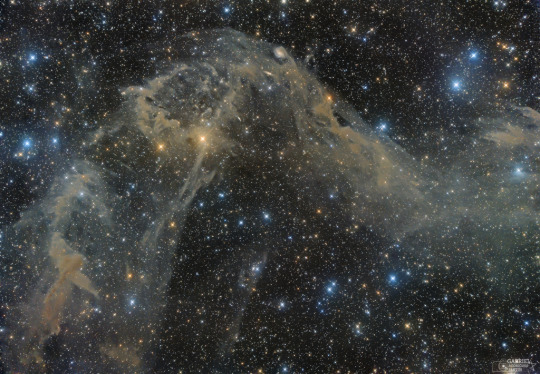
Galactic Cirrus: Mandel Wilson 9 via NASA https://ift.tt/NcQSxvF
The combined light of stars along the Milky Way are reflected by these cosmic dust clouds that soar 300 light-years or so above the plane of our galaxy. Known to some as integrated flux nebulae and commonly found at high galactic latitudes, the dusty galactic cirrus clouds are faint. But they can be traced over large regions of the sky toward the North and South Galactic poles. Along with the reflection of starlight, studies indicate the dust clouds produce a faint reddish luminescence as interstellar dust grains convert invisible ultraviolet radiation to visible red light. Also capturing nearby Milky Way stars and distant background galaxies, this remarkably deep, wide-field image explores a complex of faint galactic cirrus known as Mandel Wilson 9. It spans over three degrees across planet Earth's skies toward the far southern constellation Apus.
1 note
·
View note
Text
Galactic Cirrus: Mandel Wilson 9
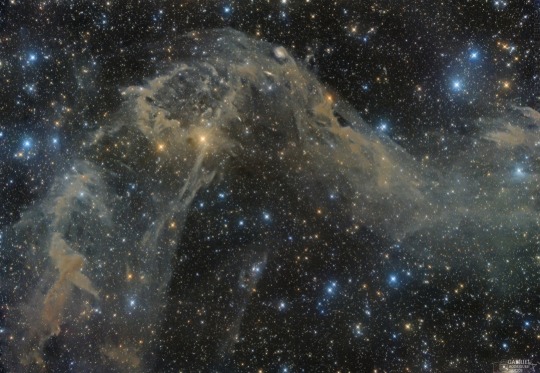
The combined light of stars along the Milky Way are reflected by these cosmic dust clouds that soar 300 light-years or so above the plane of our galaxy. Known to some as integrated flux nebulae and commonly found at high galactic latitudes, the dusty galactic cirrus clouds are faint. But they can be traced over large regions of the sky toward the North and South Galactic poles. Along with the reflection of starlight, studies indicate the dust clouds produce a faint reddish luminescence as interstellar dust grains convert invisible ultraviolet radiation to visible red light. Also capturing nearby Milky Way stars and distant background galaxies, this remarkably deep, wide-field image explores a complex of faint galactic cirrus known as Mandel Wilson 9. It spans over three degrees across planet Earth's skies toward the far southern constellation Apus.
Image Copyright: Gabriel Rodrigues Santos
0 notes
